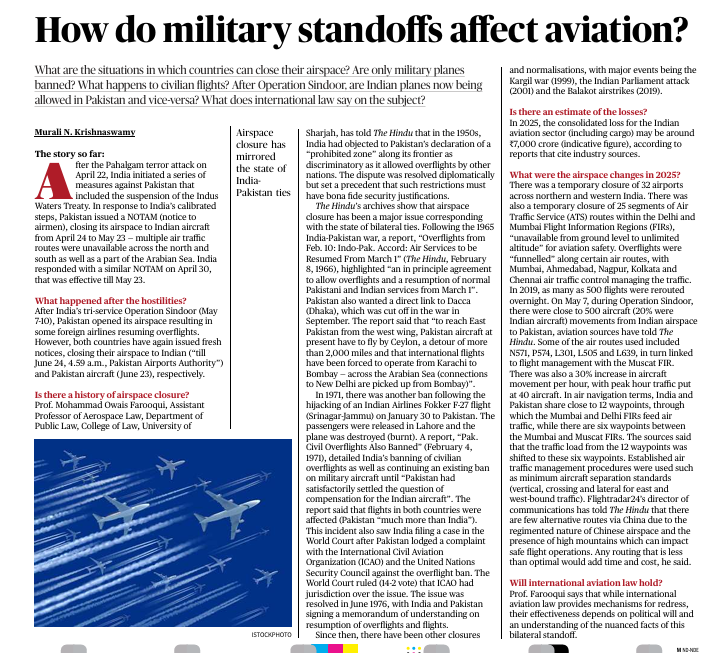1. Central Theme
- Military standoffs and their impact on civilian aviation.
- Airspace closures as non-military tools of escalation.
- Civilian and commercial aviation caught in geopolitical crossfire.
2. Trigger Event
- Pulwama terror attack (Feb 2019).
- Indian Air Force’s Balakot airstrike.
- Pakistan’s closure of airspace (April–May 2019).
- India’s reciprocal NOTAM (Notice to Airmen) issued April 30, 2019.
3. Aviation Measures and Technical Terms
- NOTAM – Notice issued to pilots regarding airspace usage.
- Overflight ban – Restriction on crossing another country’s airspace.
- IFR (Instrument Flight Rules) – Navigation rules suspended in high-risk airspace.
- Rerouting – Diversion of flight paths due to security constraints.
- “Tunneled” corridors – Heavily congested, limited navigation channels.
4. Historical Context of Airspace Closure
- 1965 India-Pakistan War – Suspension of overflights.
- 1971 War – Indian Airlines aircraft shot down.
- 1999 Kargil War – Renewed closure of overflight routes.
- 2001 Parliament attack – India imposed airspace restrictions.
- Precedent for strategic retaliation via airspace control.
5. India-Pakistan Diplomatic Tensions
- Airspace closures reflect low points in bilateral relations.
- Symbolic assertion of sovereignty and security.
- Strategic signalling without crossing into open warfare.
6. Economic and Operational Impact
- Estimated losses to Indian aviation: ₹700 crore (post-2019).
- Around 500 flights/day rerouted; 50 flights/day rerouted overnight.
- Key airports impacted: Delhi, Mumbai, Ahmedabad, Kolkata, Chennai.
- Increased fuel usage, longer flying times, ATC congestion.
7. Future Scenario (2025 Case Study in Article)
- Hypothetical closure of 32 airports in northern/western India.
- 25 IFR segments suspended in Delhi and Mumbai FIRs.
- Rerouting caused air traffic surges up to 300%.
- Increased burden on alternate hubs, e.g., Hyderabad and Muscat FIR.
8. Strategic and Security Implications
- Airspace closures used as tools of diplomatic retaliation.
- Impacts strategic aviation, cargo logistics, and national connectivity.
- Undermines air safety due to congestion and unpredictable routes.
9. Expert Insights (Prof. Owais Farooqui)
- Airspace closure mirrors military intent without kinetic action.
- Civilian aviation becomes a “political hostage”.
- Historical pattern of airspace as contested geopolitical space.
- Need to delink aviation safety from diplomatic hostilities.
10. Global Governance and Legal Gaps
- Chicago Convention (ICAO) offers limited clarity during conflicts.
- No global norms for civilian airspace closure due to warlike conditions.
- Absence of arbitration mechanisms for misuse of airspace denial.
Rising need for multilateral aviation security diplomacy.


